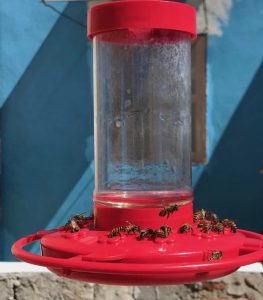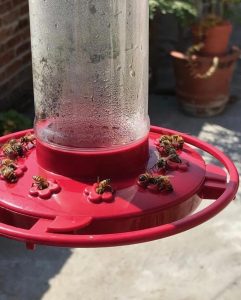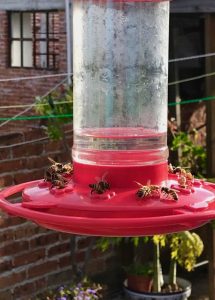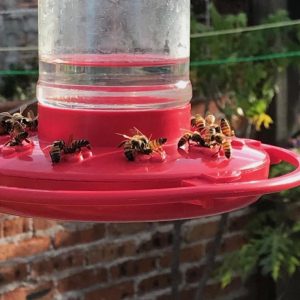If you were thinking, based on the title of this post, that it might be about sex, you’d only be partly right.
The first part, about my beloved hummingbirds and their recent invasion by swarms of nasty bees, is a too-true story. But that story leads me to drawing analogies, as I’m wont to do. This time about the sexes.

First, though, the invasion. Since I last waxed rhapsodic about “my” hummingbirds in a post titled “El Bar Colibri: On the Care and Feeding of Hummingbirds” published in September (www.blog.bonnieleeblack.com/el-bar-colibri ), I’ve increased the number of feeders on my azotea (rooftop area attached to my studio apartment) to four – strung along a long clothes line some distance apart. Word spread quickly among the hummingbird (colibri) community in this San Miguel de Allende neighborhood, and my Bar Colibri became amazingly popular.
I loved watching them – swooping in from all directions, perching on the circular bar ledge, elbowing each other when in the way, chirping and squeaking and flapping delightedly, like little kids in a plastic pool. Dozens of colibris, it seemed, at all times of the day, but even more in the evening before the bar’s closing time at sunset.
And what thirsty creatures they turned out to be! I’ve been cleaning and refilling their four feeders every day with the fresh nectar I make for them. (Recipe: one cup white table sugar dissolved in four cups hot tap water, then allowed to cool.) Yes, I’ve been going through a cup of sugar a day — spoiling them, I felt sure.
This went on for many weeks, and I was in hummingbird heaven. Then one sunny day recently I noticed that seemingly hundreds of bees had arrived in battalions, covering the surface area of the feeders and not allowing the hummingbirds to come anywhere near.

This surprised me. Hummingbirds are tiny creatures, but they’re far bigger than bees. The average hummingbird might weigh in at around 4 grams but could fatten up to about 8 grams before heading off on migration, I learned; whereas a honey bee weighs only about 3 grams.
Hummingbirds’ wings, flapping at more than 80 times per second while hovering, would surely be sufficient to shoo the bees away at close range, I thought. And their long, needlelike beaks could certainly stab at the swarms. But no. These hummingbirds demurred. They backed away. Then they stayed away. I was crestfallen.
At this point you might be tempted to advise me to Google the issue for answers to my bees-vs-birds problem. So I’ll jump right in and say: I did. And I did everything the Google gurus suggest ( https://www.perkypet.com/articles/bees-at-feeders ).
I love honey – I have some in my ginger herbal tea every afternoon — and I’d like to love honey bees. But I love my hummingbirds even more. So after trying everything else that the experts advise, I tried to come to my hummingbirds’ defense by swatting the bees away with my hands. To no avail. These invaders remain undeterred.

Finally, I’ve had to take the stance my mother took with her four children when we were small and squabbling: “You kids will just have to fight it out among yourselves,” she’d say before turning around and returning to her housework. Similarly, I’m leaving these little winged beings to work it out for themselves, letting Nature take its course. I have other things to do.
But these domineering bees have gotten me thinking about metaphorical birds and bees. Please indulge me….
Scorned – or displaced or otherwise badly stung – women have often used creature names to describe men: snakes, rats, dogs, curs (and more!). Perhaps with good reason. Personally, I prefer not to use such a broad brush when painting men; I’ve known too many good and kind ones.
But, for good or ill, I am beginning to see, as I study the bees at these hummingbird feeders, sharp similarities between men and bees. For example, bees, like men, are industrious workers, highly assertive (aggressive?), territorial, and hopelessly attracted to sweet, young, innocent, flowery things. They will stop at nothing to get what they want. They can’t help it. It’s their nature.
We women, on the other hand, are more like birds (hence the common British nickname). Yes, it’s as if we’re a different species all together from men. We need to nest. It’s futile to expect the bee in your life to be as nesty as a bird. Young women should be taught this truth early on, I believe, to be saved a lot of grief. Most older women have learned it the hard way. Just ask any of us old birds.
